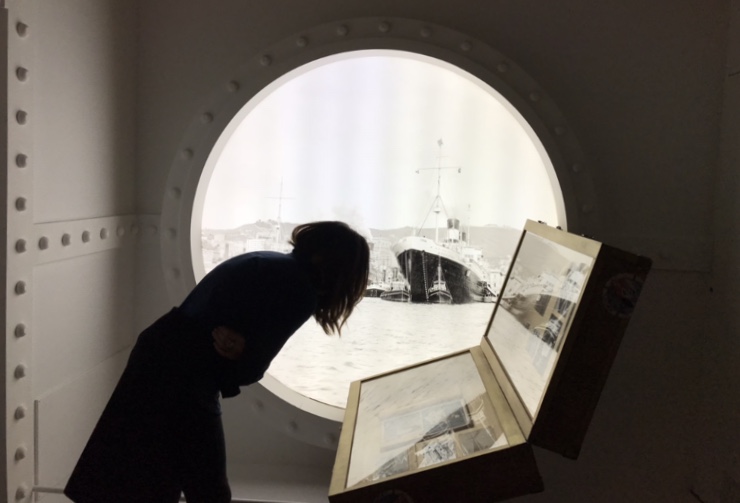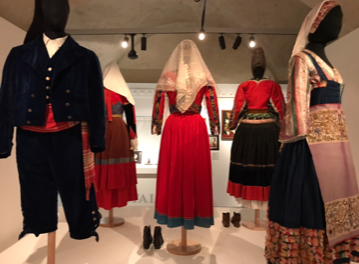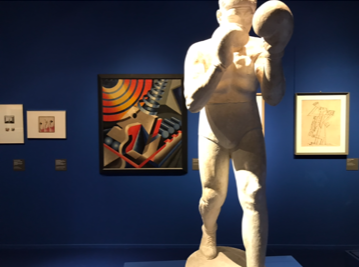
19 Maggio 2017 – 2 Maggio 2018
Museo Salvatore Ferragamo, Palazzo Spini Feroni
Di Costanza Peruzzi (Università degli Studi di Firenze)
La mostra in corso al Museo Salvatore Ferragamo, ideata dalla direttrice Stefania Ricci e curata da Carlo Sisi, è stata inaugurata lo scorso maggio 2017, in occasione del novantesimo anniversario del rientro dello stilista in Italia, dopo un viaggio di formazione in America durato più di un decennio.
Il Museo Ferragamo nacque nel 1995 per volere della moglie e dei figli dello stilista per far conoscere al pubblico la storia del fondatore del marchio e le sue creazioni, esempi di alto artigianato, considerate vere e proprie opere d’arte. Ma fin dal suo nascere, il Museo e le mostre temporanee organizzate al suo interno, hanno avuto anche un altro obiettivo, ovvero raccontare al pubblico lo stretto rapporto tra l’arte dello stilista e la cultura artistica del suo tempo.
A conferma di questo impegno culturale, nel 1999 il Museo Ferragamo ha ottenuto l’ambito “Premio Guggenheim Impresa e Cultura” (dal 2002 “Premio Impresa-Cultura”), che la collezione veneziana conferiva ogni anno alle aziende che meglio avevano investito in campo culturale.
Il crescente successo del Museo fece si che, a undici anni dalla sua inaugurazione, lo spazio espositivo venisse spostato dal secondo piano del Palazzo Spini-Feroni, al suo basamento, ornato da pilastri e volte a crocera che ne testimoniano l’origine medievale.
Lo spazio ampio del basamento, quasi ad aula unica, in passato ha reso talvolta difficile seguire il percorso espositivo pensato dai curatori, ma per quanto rigurda la mostra in questione il problema è stato eccellentemente risolto da Maurizio Balò, l’architetto che ha curato curato la scenografia dell’allestimento, ispirata agli interni di un ideale transatlantico, a ricordo dei viaggi per mare che portarono Ferragamo prima in America e poi in Italia.
E la metafora del viaggio diventa per il curatore Carlo Sisi, il fil rouge di tutta l’esposizione. Un viaggio mentale che Ferragamo compie nella cultura visiva dell’Italia degli anni Venti, che di fatto è la vera protagonista di questa mostra.
Suddivisa in otto sale, titolate e accuratamente descritte in pannelli introduttivi in italiano e in inglese, la mostra-viaggio parte proprio da video, oggetti e fotografie testimonianze dirette di quei viaggi in transatlantico di inizio secolo. Nella seconda sala si approda a Firenze e la si vede attraverso gli occhi di Ferragamo stesso, grazie ad un raro filmato che il “calzolaio delle stelle” (come era chiamato ad Hollywood) girò appena giunto in città, e attraverso gli occhi e il pennello dei pittori che in quegli anni vivevano in città, da Colacicchi, a Ferroni, a Baldwin, a Piombati Ammannati, a Rosai.
Si passa poi alle sale, forse le più empblematiche della mostra, dedicate alle arti decorative, dalla loro rinascita a partire dal rilancio del folklore e del regionalismo (Zecchin, Cambellotti), fino ad arrivare a quelle opere che hanno fatto la storia del concetto stesso di “Made in Italy”: Gio Ponti, Guido Balsamo Stella, Carlo Scarpa, Cantagalli, Lisio, Innocenti e Prosperi, Thayaht.
Interessante la sala dedicata alla figura della donna emancipata degli anni Venti, allestita nel corridoio di passaggio tra le due sale appena descritte. Una piccola parentesi che però rende bene l’idea della clientela che Ferragamo doveva soddisfare. La fisicità e il culto del corpo sono i protagonisti anche delle ultime due sale, visti da due diversi punti di vista: dal punto di vista più tecnico-scientifico nella penultima, in cui è possibile vedere attraverso testimonianze dirette, indumenti, fotografia, articoli di giornale e pubblicità, il crescente rigore scientifico che iniziava a invadere il mondo della moda, dalla disciplina tecnica, alla standardizzazione, all’imminente sviluppo delle taglie. Nell’ultima sala il culto del corpo, inteso come strumento estetico del dinamismo, è affidato alle testimonianze artistiche, pittoriche e scultoree.
Un percorso chiaro e completo che lascia al visitatore un’idea precisa della cultura che tanto affascinò e condizionò l’opera di questo intraprendente imprenditore e artista italiano, famoso già all’epoca anche dall’altra parte del mondo.
Piacevole, e più che altro importante per quanto rigurda l’impegno ammirabile della direzione nel coinvolgere anche giovani studiosi, la video installazione dedicata alla “Casa italiana” realizzata da studenti dell’Università di Firenze.
1927. The return to Italy. Salvatore Ferragamo
and the visual culture of the Twentieth Century


Salvatore Ferragamo Museum, Palazzo Spini Feroni
19 May 2017 – 2 May 2018
By Costanza Peruzzi (University of Florence)
La mostra “Made in New York. Keith Haring, (Subway drawings) Paolo Buggiani and co. La vera origine della Street Art” è stata inaugurata il 26 Ottobre 2017 e sarà ancora visitabile fino al 4 Febbraio 2018, presso le sale di Palazzo Medici Riccardi.
The exhibition at the Salvatore Ferragamo Museum, conceived by the director Stefania Ricci and curated by Carlo Sisi, was inaugurated last May 2017, on the occasion of the ninetieth anniversary of the return of the designer Salvatore Ferragamo, in Italy, after a training trip to America that lasted longer than a decade.
The Ferragamo Museum was founded in 1995 at the behest of the designer’s wife and children to let the public know the story of the founder of the brand and its creation as well as to show examples of high craftsmanship, considered to be true works of art. However, since its inception, the museum and the temporary exhibitions organized within it, have also had another goal, namely to tell the public the close relationship between the art of the designer and the artistic culture of his time.
In confirmation of this cultural commitment, in 1999 the Ferragamo Museum obtained the “Guggenheim Enterprise and Culture Award” (from 2002 “Impresa-Cultura Award”), which the Venetian group gives each year to the companies that have invested best in the field cultural.
The increasing success of the museum meant that, eleven years after its opening, the exhibition space was moved from the second floor of Palazzo Spini-Feroni, to its basement, adorned with pillars and cross-vaults which bare witness to its medieval origins.
The ample space of the basement, almost like a single hall, has made it difficult in the past to follow the exhibition path designed by the curators, but in regards the exhibition in question the problem was excellently solved by Maurizio Balò, the architect who designed the set of this exhibition. Balò was inspired by the interiors of a transatlantic ideal, in memory of the sea voyages that first brought Ferragamo to America and then to Italy.
The metaphor of the journey becomes for the curator Carlo Sisi, common thread of the entire exhibition. A mental journey that Ferragamo makes in the visual culture of Italy in the Twenties, which in fact is the true protagonist of this exhibition.
Divided into eight rooms, titled and accurately described in introductory panels in Italian and English, the exhibition-journey starts from videos, objects and photographs, direct evidence of those journeys in transatlantic of the beginning of the century. In the second room you arrive in Florence and you see it through the eyes of Ferragamo himself, thanks to a rare film that the “shoemaker of the stars” as he was called in Hollywood, as soon as he arrived in the city. In addition the visitor see it through the eyes and the brush of the painters who around the same time lived in the city, from Colacicchi, to Ferroni, to Baldwin, to Piombati Ammannati, to Rosai.
Then the visitor moves on to the halls, perhaps the most symbolic of the exhibition, dedicated to the decorative arts, from their rebirth starting from the revival of folklore and regionalism (Zecchin, Cambellotti), up to those works that have made the history of the concept of “Made in Italy” by the likes of Gio Ponti, Guido Balsamo Stella, Carlo Scarpa, Cantagalli, Lisio, Innocenti and Prosperi, Thayaht.
Interesting the room dedicated to the figure of the liberated woman of the twenties, set up in the passage corridor between the two rooms just described. A small interlude, which nonetheless gives a good idea of the clientele that, Ferragamo had to satisfy. The physicality and the cult of the body are also the protagonists of the last two rooms, examined from two different points of view: from the technical-scientific point of view in the second to last, where, through direct testimonies, clothing, photographs, newspaper articles and advertising, you can see the growing scientific rigor that began to invade the world of fashion, from technical discipline, to standardization, to the imminent development of sizes. In the last room the cult of the body, intended as an aesthetic instrument of dynamism, is entrusted to artistic, pictorial and sculptural testimonies.
A clear and complete path that gives the visitor a precise idea of the culture that so fascinated and influenced the work of this enterprising entrepreneur and Italian artist, already famous at the time also on the other side of the world.
Pleasant, and above all important as regards the admirable commitment of the management in involving young scholars, the video installation dedicated to the “Italian House” made by students of the University of Florence.